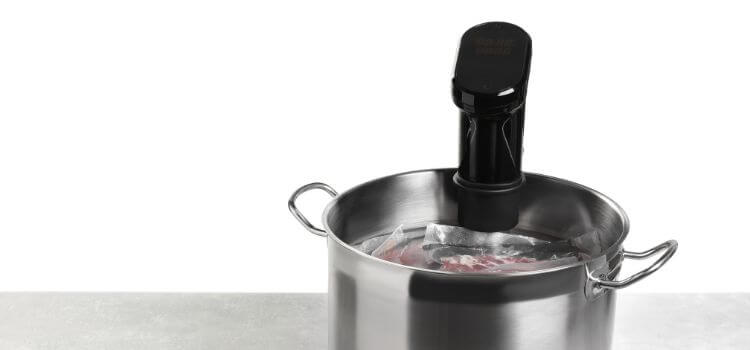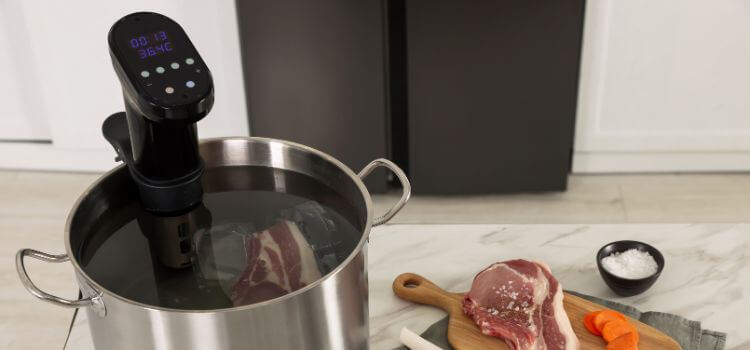As an Amazon Associate, I earn from qualifying purchases

Sous vide cooking is a culinary technique that has revolutionized the way we think about preparing food. Unlike traditional cooking methods, sous vide offers a level of precision and control that is unmatched. By vacuum-sealing food in a bag and cooking it in a water bath at a precise temperature, sous vide ensures even cooking and perfect results every time.
This method is particularly beneficial for meats, as it allows you to achieve the exact level of doneness you desire without the risk of overcooking. However, this precision can be both a blessing and a challenge. Knowing when your sous vide dish is done requires an understanding of the nuances of this cooking technique, as well as the confidence to recognize the subtle signs that indicate perfection.
Understanding Sous Vide Cooking Times and Temperatures
At the heart of sous vide cooking is the relationship between time and temperature. While temperature determines the final doneness of the food, the cooking time influences its texture and tenderness. For instance, a steak cooked at 130°F (54°C) will always be medium-rare, but the longer it cooks, the more tender it becomes. This is because sous vide allows you to break down the connective tissues in meats without overcooking the exterior.
Different types of food require different temperatures and times to reach optimal doneness. For example, poultry should be cooked at higher temperatures to ensure safety, while fish can be cooked at lower temperatures to preserve its delicate texture. Understanding these principles allows you to tailor your sous vide approach to each specific dish, ensuring that everything from chicken to carrots is cooked to perfection.
Signs That Indicate Sous Vide Food Is Done
Sous vide cooking is renowned for delivering consistent results without the guesswork. Here are key indicators to ensure your food is perfectly cooked:
- Internal Temperature: For meats, the internal temperature is the most reliable doneness indicator. Achieving and maintaining a stable internal temperature that aligns with your target ensures the food is thoroughly cooked.
- Visual Cues: Look for visual signs in your food. For fish, a slight sheen and the ability to flake easily with a fork indicate doneness. For vegetables, they should be tender yet maintain a firm texture.
- Tactile Feedback: Gently touch your food to assess its doneness. Vegetables should give slightly under pressure but not feel mushy.
- Bag Contents: Pay attention to the contents of the sous vide bag. The presence of juices and any change in color can signal that the cooking process is complete.
By combining these cues, you can ensure your sous vide creations are perfectly cooked every time.
Tips for Checking Doneness Without Cutting Into the Food

One of the advantages of sous vide is that you can check for doneness without having to cut into the food. While the internal temperature is a key indicator, using a digital thermometer can provide quick and accurate spot checks. Simply insert the thermometer into the thickest part of the food to ensure it has reached the desired temperature.
Another method is the pressure test, which involves gently pressing on the food to gauge its firmness. This technique is particularly useful for steaks and other meats, as it allows you to assess tenderness without compromising the presentation.
Common Mistakes to Avoid
Common mistakes in sous vide cooking to avoid:
- Relying solely on cooking time: Always consider cooking time alongside temperature for best results.
- Ignoring the initial food temperature: Make sure your food starts at the right temperature to achieve accurate cooking times.
- Neglecting precise temperature control: Use a reliable sous vide machine and regularly monitor water temperature to prevent inconsistent outcomes.
Conclusion
Determining when sous vide food is done requires an understanding of both the science and art of this cooking method. By mastering the relationship between time and temperature and learning to recognize the subtle signs of doneness, you can ensure that every dish is cooked to perfection.
Utilize sous vide cooking charts and guides to refine your technique, and consider joining online communities where you can share insights and recipes with fellow enthusiasts. With practice and attention to detail, sous vide cooking can become a seamless and enjoyable part of your culinary repertoire.
FAQ
How do you know if sous vide is done?
Sous vide food is done when it reaches the desired internal temperature and maintains it consistently. Use a digital thermometer for spot checks. Visual cues like color and texture, along with firmness tests, can also help confirm doneness without cutting into the food.
What temperature is Suvi cooking?
Suvi (or sous vide) cooking typically ranges from 120°F to 185°F (49°C to 85°C), depending on the food. For meat, it varies with the desired doneness: rare to medium-rare steaks at 130°F (54°C) and chicken at around 165°F (74°C). Vegetables might require higher temperatures.
How do you set the temperature on a sous vide?
To set the temperature on a sous vide, first connect your sous vide device to power and submerge it in a water bath. Use the device’s interface or an app to input your desired temperature. Precision is key, so ensure the temperature matches your recipe’s requirements for optimal results.
Your FAQ answers are ready! If there’s anything else you need help with, just let me know.
As an Amazon Associate, I earn from qualifying purchases